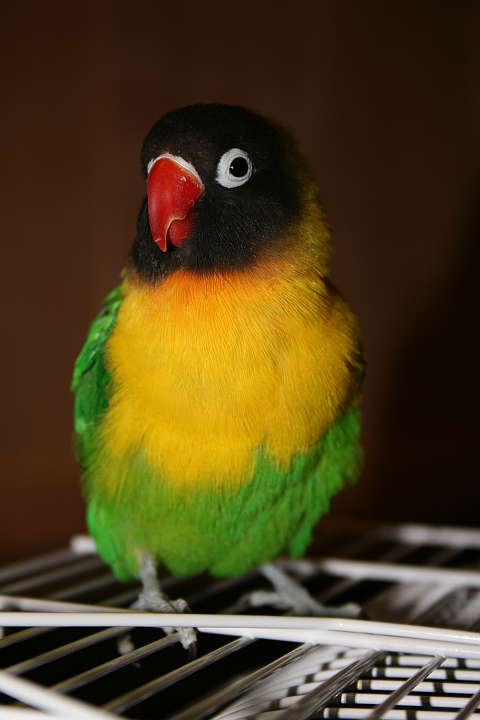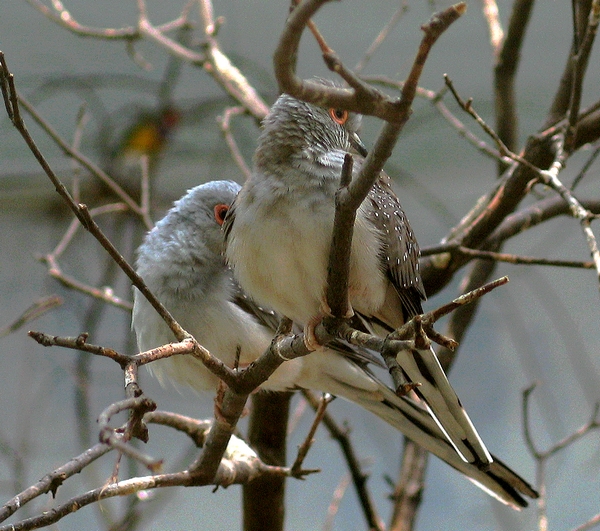 General
General
Small size, a hearty constitution and fearless personality render the Masked Lovebird an excellent choice when venturing into parrot-keeping – yet these Tanzanian natives are so engaging that they remain common in the collections of even very advanced aviculturists. Please see The Masked or Yellow-Collared Lovebird, Agapornis personata – Natural History for information on Masked Lovebirds in the wild.
Cage and Physical Environment
As with all birds, the largest enclosure possible should be chosen, with a minimum size being 36” x 36” x 18” for a pair (or slightly smaller if the birds are exercised often – Blue Ribbon Series T-10 Cage). The width between the bars should be no more than ¾ of an inch – frightened lovebirds may squeeze through wider bars that contain them when calm.
The cage should be provisioned with perches of various widths and materials, with the most-utilized perch being of a thickness that allows the birds’ feet to extend about three quarters of the way around. A birdbath should be provided.
These little dynamos should be kept busy – they have an affinity for shredding bark and should be given lots of willow, fruit tree and other non-toxic branches.
Masked Lovebirds housed in an outdoor aviary will provide you with quite a treat – they never stop exploring (or destroying any plants they get hold of!) and interacting with what is going on outside the aviary.
Light, Heat and Humidity
Having evolved in a harsh environment, Masked Lovebirds are resilient as regards temperature. On winter nights in their native Tanzania, temperatures regularly drop to 45 F, and sometimes lower. Properly acclimated birds have been over-wintered outdoors in England (they are provided with a dry, frost-free shelter). They are, however, sensitive to moisture, and will not thrive if allowed to become damp and chilled.
An average humidity of 60% or so is ideal, but drier is fine except in the case of breeding pairs (please see below).
Masked Lovebirds kept indoors should be provided with a full spectrum bulb, such as the Zoo Max Avian Sun UVB Bulb.
Feeding
Despite their rather outsized beaks, the majority of the Masked Lovebird’s diet should be composed of a small seeds, such as canary and white and yellow millet, along with a bit of hemp and sunflower (Sunburst Medium Parrot Food) and a high quality pelleted food (Lafeber Daily Diet – Pellets). They favor sprouting greens (Vitakraft Sprout Pot), a variety of fruits and some vegetables (individual preferences vary). Cuttlebone and grit should always be available.
Image referenced from Wikipedia, http://en.wikipedia.org/wiki/Image:Masked_Lovebird_(Agapornis_personata)_pet_on_cage.png, uploaded by Epoulin
 That Bird Blog – Bird Care and History for Pet Birds
That Bird Blog – Bird Care and History for Pet Birds

 Like many bird fanciers, I was long drawn to the quiet beauty and calm demeanors of the various doves, but held back due to the large flight cages required by most, and the relative delicacy of the smaller species. That is, until I discovered the Diamond Dove. Barely larger than a canary, this tiny beauty is also quite hardy and long-lived, and is an ideal introduction to the group.
Like many bird fanciers, I was long drawn to the quiet beauty and calm demeanors of the various doves, but held back due to the large flight cages required by most, and the relative delicacy of the smaller species. That is, until I discovered the Diamond Dove. Barely larger than a canary, this tiny beauty is also quite hardy and long-lived, and is an ideal introduction to the group. Toucans have long enchanted bird keepers and “regular people” alike. Having kept several large species in zoos, I can attest that their bright colors and clownish appearances are matched by their behavior. I have seen them toss grapes to one another for no apparent reason (mated pairs and youngsters were not involved) and engage in “beak dueling” bouts with no signs of aggression at all. All were unfailingly curious about me, and soon fed readily from my hand.
Toucans have long enchanted bird keepers and “regular people” alike. Having kept several large species in zoos, I can attest that their bright colors and clownish appearances are matched by their behavior. I have seen them toss grapes to one another for no apparent reason (mated pairs and youngsters were not involved) and engage in “beak dueling” bouts with no signs of aggression at all. All were unfailingly curious about me, and soon fed readily from my hand. considered by many ornithologists (biologists who study birds) to be the most intelligent of the world’s 9,000+ bird species. People have apparently held this view from the earliest of times, as the folktales and legends of many races are filled with tales attributing great powers and cunning ways to these impressive birds.
considered by many ornithologists (biologists who study birds) to be the most intelligent of the world’s 9,000+ bird species. People have apparently held this view from the earliest of times, as the folktales and legends of many races are filled with tales attributing great powers and cunning ways to these impressive birds. of the extinction of the USA’s only native breeding parrot, the Carolina Parakeet, Conuropsis carolinensis. The last known specimen of this species died in 1918, in the Cincinnati Zoo. However, a spectacular, pigeon-sized parrot once frequented the mountains of southern Arizona and New Mexico, gorging on pine cones before migrating south to breed.
of the extinction of the USA’s only native breeding parrot, the Carolina Parakeet, Conuropsis carolinensis. The last known specimen of this species died in 1918, in the Cincinnati Zoo. However, a spectacular, pigeon-sized parrot once frequented the mountains of southern Arizona and New Mexico, gorging on pine cones before migrating south to breed.